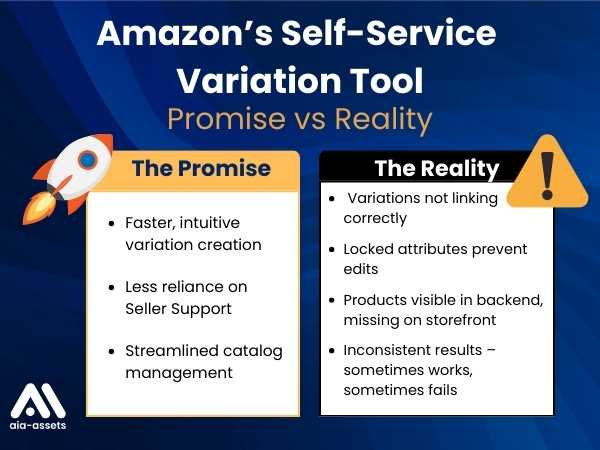When Amazon rolls out a new feature, sellers often hope for efficiency, scalability, and clarity. Unfortunately, the recent self-service variation tool has introduced as many headaches as it has solutions.
On paper, this rollout should have been a game-changer: a faster, more intuitive way to create and manage variations without the constant back-and-forth with Seller Support. But in practice? Many sellers are finding themselves more blocked than ever.
This isn’t an isolated incident. Across multiple categories, sellers are reporting the same frustrations:
Variations not linking correctly
Locked attributes preventing updates
Products displaying live in the backend but missing from the storefront
Inconsistent results—sometimes it works, sometimes it fails without reason
Interestingly enough this “streamlined” tool seems to be pushing sellers back toward the old-school 3P approach: flat file uploads and manual catalog management.

Variations aren’t just a backend convenience—they’re a critical driver of conversion and visibility. Shoppers expect to see all product options consolidated in one place. Without proper variation linking, sellers risk:
Losing sales to competitors who appear “more complete”
Lower conversion rates due to scattered product pages
Frustration for customers who can’t easily browse options
Until Amazon irons out the bugs, sellers are leaning on proven workarounds, such as:
Flat File Uploads – Download the catalog template, assign parent/child relationships manually, and re-upload. (Yes, tedious—but still the most reliable.)
Recreate Parent Listings – Remove existing links, rebuild the parent ASIN in self-service, then add all child ASINs together.
Catalog Team Requests – If attributes are locked, open a case under “Product Variations – Linking or Removing” and request that Amazon unlocks the parent.
Persistence – Variations may fail half the time, but repeated attempts, paired with open cases, often get them live.
Amazon’s ongoing upgrades signal a larger shift: the platform is trying to standardize and automate catalog management, reducing dependency on manual interventions. That’s the right direction long-term—but the growing pains are real.
This shows that adaptability is non-negotiable. Success on Amazon has always been about navigating evolving rules, systems, and glitches. Those who know the workarounds—and have the patience to execute them—gain the edge while others stall out.

At AIA Assets, we’ve been through these issues firsthand, and we’ve helped sellers restore and create variations when the system said “no.” If anything, this new tool underscores the importance of expert guidance—because the difference between a broken listing and a clean variation can be the difference between stagnation and scale.
Ready to explore how AIA ASSETS can help you on your journey to success with Amazon Seller Central? The team at AIA Assets is here to guide you.

